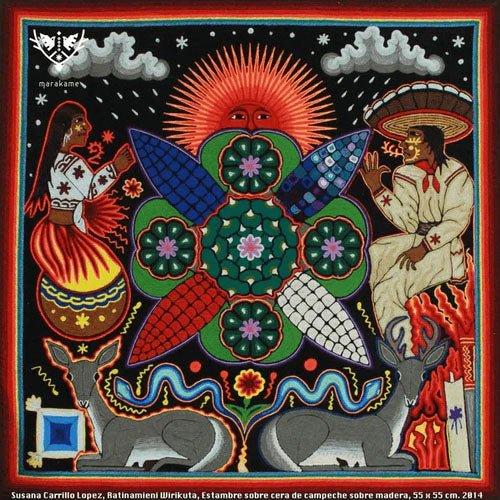The Wixáritari People (Huicholes) and Art.


By MC Javier Ignacio Martínez Sánchez
Perhaps a window that allowed the world to find out about the existence of peoples that had a tiny fabric with the elements of nature and their movements that generate life, was Art. The Wixaritari (Huichols) who inhabit the steep ravines of the Sierra Madre Occidental in Mexico (a region called the Gran Nayar[I]), they are a people of artists.
The first glances at the "art" of the world Wixarika (Huichol) were recorded in the 2013th century by anthropologists such as Carl S.Lumholtz, León Diguet, Robert M. Zingg and Konrad Theodor Preuss. Those who collected the first collections of works exhibited by museums such as the ones in Chicago, New York, Berlin and Paris (embroidery, textiles, wood and stone sculptures, arrows and jicaras adorned with beads) (Neurath, J., XNUMX[ii]).
Today the art of Wixaritari It is known worldwide, thanks in large part to globalization, among other factors. Recognized researchers of this fascinating family of symbols and rites have finely described the relationship that exists between the “living” artistic work, the “ancestral deities” (springs, peaks, hills, plants and animals), the social organization within the communities, the architecture of their ceremonial centers and the way of seeing the world; in other words, his worldview.
The tradition Wixaritari Beyond its conceptual descriptions (which help us as carriers of a mestizo culture to approach its unknown world), it is a strenuous annual activity that involves family members (men and women) from within their communities to fulfill a traditional position. . These charges are varied in time, form and function, for the moment it is not our objective to describe them, but to mention that they are very demanding in their demand for time and effort. Anyone who has a traditional position, leaves for long periods during the year or years that lasts, any "extra-home economic activity". Such as working as day laborers in the pinch of tobacco, as braziers in the United States and the same production of modern works of art Wixaritarisuch as bracelets, backpacks, earrings, worsted boxes, necklaces and ornamental pieces of chaquira.
Most families Wixaritari if not all are organized in such a way that some member helps to sustain the realization of the tradition. If a family member is assigned a position, the other members will contribute in solidarity to cover the monetary expenses that this traditional activity causes them (purchase of candles, ribbons, per diem, animals to make offerings, expenses to carry out the traditional hunting of the deer , delivery of offerings in its main sacred places that are located in different states of the Mexican republic from west to east and from south to north, in addition to the center, etc.).
In this way perhaps it has been like many women and men wixaritari They have become consummate artists, emigrating to the country's main cities and dedicating themselves almost exclusively to making work and find ways to sell it. A strategy to preserve tradition? ...
[I]Region that includes portions of the states of Nayarit, Jalisco, Durango and Zacatecas. (Neurath, J., 2013)
[ii] The Life of Images. Huichol art. Johannes Neurath. First edition. CONACULTA. 2013


